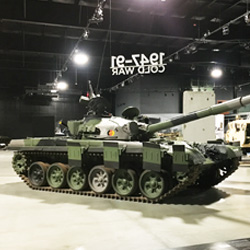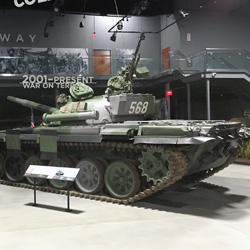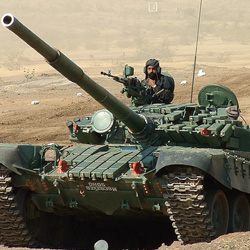The T-72 is a family of Soviet main battle tanks that first entered production in 1971. The Russian T-72 main battle tank was produced at the Malyshev HMB Plant, based in Kharkov, Ukraine and at UKBM Nizhny Tagil, Russian Federation and produced under license in a number of countries. The T-72 first entered production in 1972 and an estimated 50,000 have been built. It was widely exported and saw service in 40 countries and in numerous conflicts. The T-72 was the most common tank used by the Warsaw Pact from the 1970s until the collapse of the Soviet Union in 1991. The T-72 has been exported to Algeria, Bulgaria, Cuba, the Czech Republic, Slovakia, Finland, Hungary, India, Iran, Libya, Myanmar, North Korea, Poland, Romania, Syria and Yugoslavia.
The tank is fitted with a 125mm D-81 smoothbore gun, a 7.62mm co-axial machine gun and a 12.7mm air defense machine gun mounted on the commander’s cupola. The T-72S carries 45 rounds of 125mm ammunition, 22 rounds of which are carried on an automatic loading carousel. The T-72M is an export version, similar to T-72A but with simple steel armor. Also built in Poland and former Czechoslovakia.
Various versions of the T-72 have been in production for decades, and the specifications for its armor have changed considerably. Original T-72 tanks had homogeneous cast steel armor incorporating spaced armor technology and were moderately well protected by the standards of the early 1970s. In 1979, the Soviets began building T-72 modification with composite armor similar to the T-64 composite armor, in the front of the turret and the front of the hull. Late in the 1980s, T-72 tanks in Soviet inventory (and many of those elsewhere in the world as well) were fitted with reactive armor tiles.
Laser rangefinders have appeared in T-72 tanks since 1978; earlier examples were equipped with parallax optical rangefinders, which could not be used for distances under 1,000 meters (1,100 yd). Some export versions of the T-72 lacked the laser rangefinder until 1985 or sometimes only the squadron and platoon commander tanks (version K) received them. After 1985, all newly made T-72s came with reactive armor as standard, the more powerful 840 bhp (630 kW) V-84 engine and an upgraded design main gun, which can fire guided anti-tank missiles from the barrel. With these developments, the T-72 eventually became almost as powerful as the more expensive T-80 tank, but few of these late variants reached the economically ailing Warsaw Pact allies and foreign customers before the Soviet bloc fell apart in 1990.
The T-72 is extremely lightweight, at forty-one tons, and very small compared to Western main battle tanks. The T-72 has a nuclear, biological, and chemical (NBC) protection system. The inside of both hull and turret is lined with a synthetic fabric made of boron compound, meant to reduce the penetrating radiation from neutron bomb explosions. The crew is supplied clean air via an air filter system. The modernized T-72M1 featured an additional .63”of high hardness steel appliqué armor on the glacis plate, which produced an increase of 1.7”in line of sight thickness. It was also the first export variant with composite armor in the turret, containing ceramic rods sometimes called “sandbar armor”.







